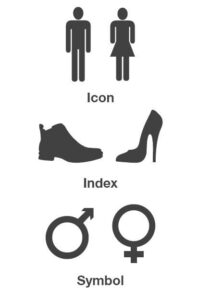Semiotics
We live in a world of signs and symbols, from past or present (Grin, 2017). We come across countless visual keys that trigger our mind to relate what we see into something that we can identify or something that we understand. This gives us possibilities of creating visuals with the intention of portraying messages to an audience.
By definition, semiotics is the study of symbols, signs and signage. It may be argued that signs can also be drawings, paintings and photographs, but may also include words, sounds and ‘body language’. The methods used in semiotics help us with an approach to study and to establish the ‘cultural meaning’ of media content’ (Grin, 2017).
Saussure, a Swiss linguist who studied and evolved the way we see semiotics, divides the sign into two distinct components which are; the signifier (‘sound-image’) and the signified (‘concept’) (Berger, 2012). For Saussure, the signified and signifier are purely psychological: they are form rather than substance. (Berger, 2013). The signifier may be interpreted as the material form, and the signified as the mental form, concept or idea.
Denotation and Connotation
Denotation is the most basic or literal meaning of a sign, e.g., the word “rose” signifies a particular kind of flower.
Connotation is the secondary, cultural meanings of signs; or “signifying signs,” signs that are used as signifiers for a secondary meaning, e.g., the word “rose” signifies passion.
Icon, Index, Symbol
- Icon – A sign which is similar in appearance to something we relate to
- Index – A sign which is related to something that we understand is related to; having a cause-and-effect relation between the sign and meaning of the sign
- Symbol – A sign drawn or digital which has a form that we relate to or understand
In conclusion, we use semiotics to portray an instruction, social que or message by understanding the nature of things, understanding what to do to achieve the message, and the ability to communicate these things to another (Thoughtco, 2020).
References:
mediatexthack in Signs and Signifiers, 2013. [Accessed on 16/12/2021]
https://vanseodesign.com/web-design/icon-index-symbol/ [Accessed on 16/12/2021]
https://www.uvm.edu/~tstreete/semiotics_and_ads/terminology.html [Accessed on 16/12/2021]
https://en.wikipedia.org/wiki/Signified_and_signifier [Accessed on 16/12/2021]


